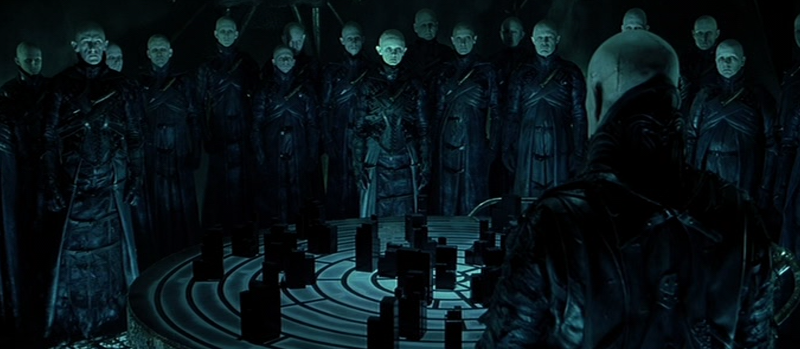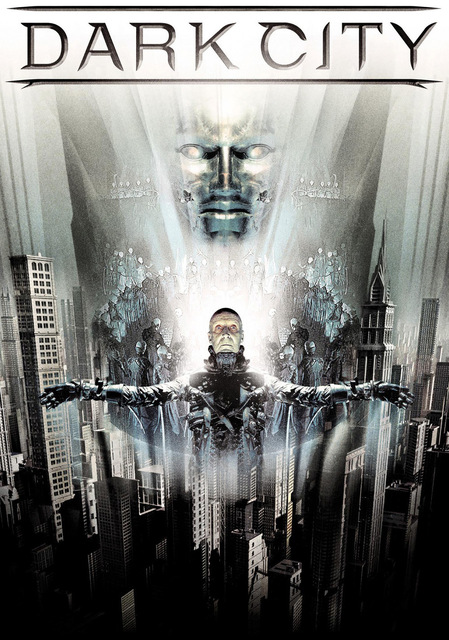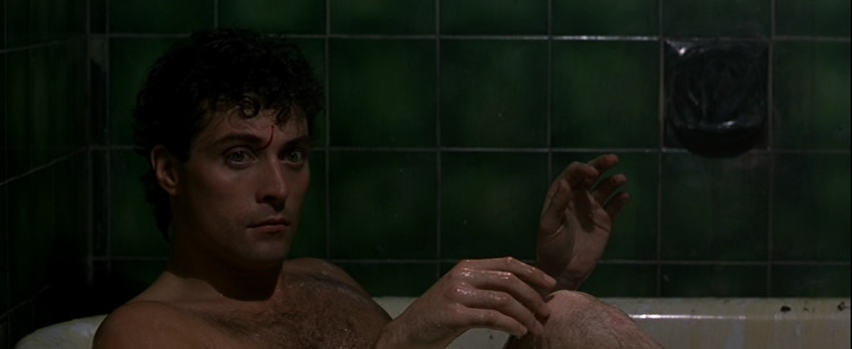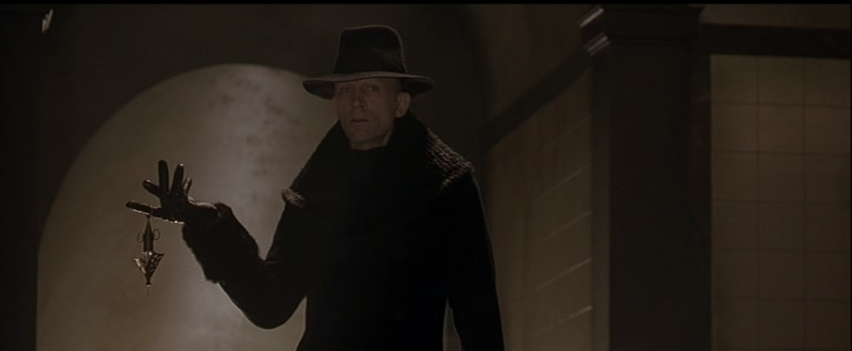

“Can you come up with a single memory? You can’t, can you? You know something, I don’t think the sun even exists in this place. ‘Cause I’ve been up for hours, and hours, and hours, and the night never ends here.”
Alex Proyas began his feature filmmaking career with the visually dazzling, post-apocalyptic indie oddball Spirits of the Air, Gremlins of the Clouds before jumping into the big leagues with The Crow. Despite bringing a singular vision to the screen in adapting James O’Barr’s underground gothic comic, Proyas’s unique sophomore film will always be overshadowed by Brandon Lee’s death on set. It wouldn’t have become a cult classic without true cinematic merit (or, maybe it would have; cult fandoms don’t always make sense), but its reputation is inextricably bound up in that tragedy. As a result of that, it’s not really fair to use it as an evaluative tool when measuring the legacy of its director. Instead, we must look to his next film, which, for my money, is his best.
Dark City is a rare breed of film, one that matches its conceptually inspired and thought-provoking themes with an equally inventive visual style and setting. Released more than a year before The Matrix, Dark City led viewers through a similar nightmarish exploration of reality. Like that film, too, it had a memorable visual texture, presenting us with an ever-morphing city that is perpetually shrouded in darkness. As our protagonist explores its heights and seedy depths, the design inspirations range from Brazil (1985) to Metropolis (1927), from Blade Runner (1982) to The City of Lost Children (1995), giving us a mid-1940s New York neo-noir vibe blended with elements of steampunk as a backdrop for our existential dystopia.

But Dark City never steps near the detrimental trap of “style over substance.” In fact, it’s plot is so brainy that the panicky studio (New Line Cinema) thought that audiences would be too dumb to understand it, forcing Proyas to add a detestable voiceover to open the film. It spoils too much of the initial mystery, but the film remains thoroughly engaging even as it stumbles out of the starting blocks. The film opens in the middle of a fractured narrative, as John Murdoch (Rufus Sewell) awakes naked in a bathtub without a memory of himself or his actions. He doesn’t even learn his name until several scenes into the movie. In the room with him is a broken syringe and a dead hooker with symbols painted in blood on her bare torso. He’s not sure if he killed her or not. Dr. Schreber (Kiefer Sutherland)—who just informed us in the opening narration that he has betrayed his fellow humans and now performs tests on them in service of “the Strangers”—rings Murdoch’s grungy hotel room from a payphone, offering the amnesiac what help he can.

Very quickly, Murdoch (still clueless regarding his identity or his past actions) finds himself on the run from ghastly walking corpses that seem capable of bending physical reality. Led by Mr. Hand (Richard O’Brien—Riff Raff in The Rocky Horror Picture Show) and Mr. Book (Ian Richardson), the Strangers live underground in a Metropolis-like lair where they orchestrate daily “tunings”—alterations to the physical and mental reality that their human test subjects experience. Every time the clock strikes midnight, the entire human population falls asleep for a few moments as buildings spring from the ground, memories are ported via syringe from one mind to another, and the Strangers are free to move about unnoticed.
Our protagonist is unique, though. One night—the one on which our narrative opened—he was being implanted with memories of murdering a prostitute; he woke up just as Dr. Schreber was plunging the syringe into him. Now he can’t sleep at all, and he begins to telekinetically manipulate the physical world around him—breaking locks, creating doorways, and knocking back pursuers—when under intense pressure. He begins to question everything he thought he knew. He realizes that he can’t remember the last time he did anything during the day, or how to get to his hometown; in fact, nobody he asks remembers these things either. He even begins to suspect that his memories of his wife Emma (Jennifer Connelly) may not be real. Apparently she had an affair which caused his psychotic break and subsequent murder spree. But he remembers none of it, and doesn’t believe any of it is true. He blindly hurtles forward into obstacles in pursuit of finding out who he is.

Inspector Bumstead (William Hurt), who was assigned Murdoch’s case, eventually tracks him down. Harboring his own doubts about the nature of reality, Bumstead chooses to aid Murdoch. They capture Dr. Schreber and force him to explain why the Strangers have initiated a large-scale experiment on humanity. It gets pretty bleak, especially when compared to its most obvious contemporary. In The Matrix, humans sowed the seeds of their own destruction by creating the machines and then going to war with them;1 in Dark City humans are kept inside Plato’s Cave by a hive mind alien race that uses human corpses as hosts and is trying to understand the concept of human individuality in order to save their dying race.
If there’s a true fault with the film it is that it tries to neatly wrap things up, and in doing so forces a climactic psychokinetic battle between Murdoch and Mr. Book. It doesn’t quite work, and takes something away from the slick moody sheen of the cerebral buildup. It doesn’t exactly spell everything out, but basically love conquers all. The end. It feels a little bit rushed and unsatisfactory, but it’s not bad. The film concludes with Murdoch introducing himself to his wife, who has been given new memories and a new identity.2
The film was a commercial failure, barely recouping its production costs at the box office (which means it was a huge flop because that doesn’t include promotional costs), generating roughly 6% of the box office proceeds that The Matrix would rake in a year later. I think there are several reasons for this stark contrast in marketability. While both films are endlessly clever and cover similar thought-provoking territory, The Matrix is much better at making you feel like you “got it” even if you only “got” the bare minimum; whereas Dark City intentionally leaves you in the dust if you’re not paying attention (or, according to those who made the film, if you’re dumb3). Further, Dark City can’t really match the “wow” factor of the action sequences in The Matrix, so it relies much more on engaging its audience intellectually.4

Dark City is a lasting testament to the visionary prowess of Alex Proyas. Unfortunately, the filmmaker has yet to top this highwater mark since its release. Just like the Wachowskis, he channeled a diverse array of influences—Katsuhiro Otomo’s Akira, 1940s noir films such as The Third Man and The Maltese Falcon, and German expressionist films like Nosferatu and M. (The film’s palette is very dark but the lighting is incredible.) It’s a wonderful miscellany that Proyas culled from a vast and varied history of cinema.
The film’s reputation grew as it entered the home video market and found itself on several best of the year lists. Whether the film influenced other filmmakers of the era is debatable, but it was the first of a group of films that all came out within a few years and explored similar existential material—The Truman Show, Pleasantville, Being John Malkovich, eXistenZ, The Thirteenth Floor, Memento, Equilibrium. It was even considered an inspiration by Christopher Nolan when he began writing Inception.
Often films that try to provoke questions end up force feeding the audience or barely touching on the issues at all. Dark City is able to make it work by raising the questions organically as its thrilling plot unfolds. It has its flaws, sure, but the reputation it has garnered as the years have passed is well deserved.
1. If only they had read Dune, they would have known it was a bad idea to create thinking machines.
2. A cool bit of movie trivia: the final scene, in which Jennifer Connelly stands on an ocean dock, is repeated in two other movies with Jennifer Connelly—Requiem for a Dream (2000) and House of Sand and Fog (2003).
3. Proyas, regarding the opening narration: “It was definitely there for the dummies, there’s no question.” Sewell agrees, “I think they probably felt they didn’t want to alienate certain people. But I just think, ‘Fuck ‘em.’” I don’t exactly agree with the demeanor, but I certainly appreciate the desire to forge ahead with their vision uncompromisingly. Unfortunately, Proyas always seems to run into disagreements with studios.
4. Maybe that just reiterates the “dumb people won’t like it” comments. But at the very least, kids who might enjoy The Matrix for the same reason they enjoy superhero films or Star Wars probably wouldn’t enjoy Dark City.
Sources:
Watt, Jake. ”Revisiting ‘Dark City’ 20 Years Later; The Most Underrated and Influential Sci-fi Film Ever?”. Switch. 24 February 2018.